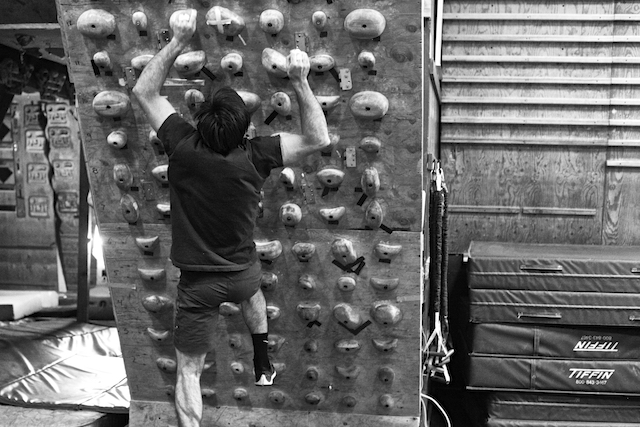
By Jordan Smothermon
We’ve begun investigating the relationship between strength and strength endurance required for different types of holds in climbing.
Our question was simple: does the strength endurance for one type of hold correlate to another type of hold?
Mini-Study Design
In our first investigation of a small sample size, we looked at whether or not pinch grip strength endurance correlates to open hand finger strength on an edge hold, including 4 and 2-finger combinations.
Our methodology was to have athletes hang for time from a number of holds with only their body weight as resistance. A uniform rest period was given between bouts. We started from a pinch hold mounted at 45 degrees from vertical on a board mounted at a 45-degree overhanging angle. Then, they moved to a campus board mounted at 10 degrees with an 1-1/2” edge and hung by three different two-finger combinations (called “teams”), in order: pinky-ring (3rd team), ring-middle (2nd team), and middle-index (1st team). Then they performed pull-ups to failure – dead hang with full elbow extension. Finally, they moved to the campus board again and performed another hang with four fingers, open hand.
 Results and Discussion
Results and Discussion
In general, pinch grip strength endurance did correlate to four finger open hand strength endurance, with four finger times being 90% of pinch grip times. on average. Two finger hang teams presented some difficulty as they are so difficult to hang from, with only one of our climbers able to hang for any time from the 3rd team. The second and first teams were closely related to one another, with the first team (middle-index) being the stronger combination for every climber, and five seconds longer of a hang time, on average, than the 2nd team.
Also, the 1st and 2nd team times correlated, almost across the board, to pinch times – so, the longer you could hang from pinches, the longer you could hang from your 1st and 2nd two finger team. On average, for every five seconds, you gain on pinch holds equals two more seconds of 1st team hang time. For the second team, every 4 more seconds of pinch grip time you gain equals 1 more second of 2nd team hang time.
The variance between results depended on the type of climber each subject was. Pinch times and correlations were longer and closer for sport climbers. Trad climbers, on the other hand, had smaller hang times and less of a correlation between the types of holds.
The practical application of these initial findings could be used to design progressions for a training plan based solely off of pinch grip time since we have a general proportion of how pinch grip matches up with open hand gripping. Yet, as of right now, any progression and plan based on these findings would be more accurate for sport climbers over trad climbers.
Next Steps
Over time, we’ll need to collect more data points to more accurately cull normative values for climbers. From there, we could aim to train athletes to that normative value of pinch grip correlation. Then, as they continued training and moved to more specific objective-based training, their training would shift as well to better align the ideal strength proportion to the type of climbing their objective demands. This would represent a significant jump in specific climb training that is precisely targeted to the goal at hand.
You Might Also Like Grip Strength. Does it matter? How to test it. How to train it.
